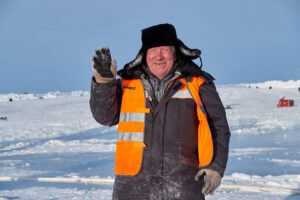On one of my visits to Greenland’s capital Nuuk, I went to an open-air market called Braedtet (The Plank) in search of my supper. Displayed on tables as well as piled on the ground, I saw dead kittiwakes, briskets of reindeer, walrus aortas, dried whale meat, mikiaq (decomposing seal heads), and various types of fish, along with head-shot seals skinned to the nose and hung vertically on ropes.
Needless to say, there were no carrots, cauliflower, asparagus, or brussels sprouts. Soon, a short woman with a soft round face and shoulders like a fullback’s tried to interest me in buying some qimmeq (dog). She pointed to some light brown meat lying in a heap on a table.
“Qimmiaraq [puppy]?” I asked. For I knew that the puppies of sled dogs were occasionally strangled and their fur used to provide trim for a child’s parka. Might a dead puppy sans fur be sold as cuisine?
The woman shook her head, uttering a word I didn’t catch — maybe the local word for an adult dog that had become unmanageable or one that had outlived its usefulness as a sled animal, and whose sole purpose now was to be eaten. (Note: As the custom of using sled dogs has declined in Greenland, so has the custom of eating them.)
Unlike explorer Vilhjalmur Stefansson, who balked at the idea of eating man’s best friend (woman’s best friend, too), I had no qualms about doing so myself. Indeed, I was curious about the taste of a former sled dog. So I asked for a pound or so of the meat. After the woman took my kroner, she handed the meat to me, saying, “Nerilluarisi! [Bon appetit!]”
Back at my tent I cut the meat into chunks and cooked those chunks for a relatively long time over my Primus stove. Since I didn’t have any basil, dill, oregano, garlic, or thyme with my gear, I was obliged to eat the meat without a seasoning. But this at least gave me a good idea of how Greenlandic sled dog actually tastes.
How, in fact, did the meat taste? For starters, it was so chewy that I felt like I was eating mostly muscle and sinew, as might be expected from an animal that had devoted its entire life to pulling sleds. It also had a strong but rather generic animal flavor. Even though its primary food had been fish, the meat did not have a fishy flavor. If I wanted to be off-putting, I’d say that the taste reminded of the smell of a wet dog. A kinder way to describe it would be to say that it would have benefited from some hot sauce.
Here’s perhaps a still kinder way to describe it: By dining on a Greenlandic sled dog, I was again putting to work an animal that had dedicated its life to working for my species.






